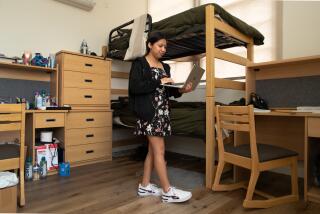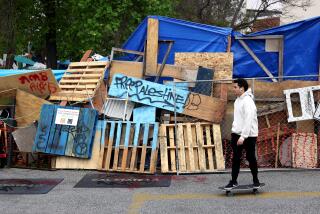Homeless Awareness Week at Pitzer : Looking at Life From the Streets
- Share via
When the sun’s early rays hit the cardboard box she was sleeping in, Cheryl Droge dragged her cold, aching body from its narrow shaft and squinted at the strange contrasts around her.
Here she was in a shantytown without basic comforts, yet she was warming herself on the manicured lawn of prestigious, private Pitzer College, where she is a student.
Her ordeal was part of Homeless Awareness Week at the college, where several students have been sleeping in boxes and crates every night since Monday. On Friday, they plan to join the real homeless and spend the night with them on the streets of Los Angeles.
Droge, a sophomore sociology major whose family recently moved to Santa Ana from New York, said she “definitely got a feeling of being homeless. I wouldn’t want to go on all day like this. If I had no place to go after sleeping in a box, I think I’d just turn off my brain and stay in the box.”
Heightening Awareness
She and the other participants believe that if they suffer some of the indignities and discomforts of urban homelessness, they may heighten their own awareness and awaken their fellow students to a social ill they hope to cure.
“Typically Pitzerish” is how Jane Holcombe, vice president for student affairs and dean of students, judged the project, which has temporarily defaced the central campus of the youngest of the six Claremont Colleges.
“I think it’s wonderful,” Holcombe said.
“It was terrible,” said student Francine Caporale, awakening from the first night of her weeklong outdoor experience. “The ground was hard and I almost froze. All I had was this old comforter with holes.”
Added Betsy Heilman: “When you wanted to sit up, you had to squish out of the box. I have a headache.”
Feelings Intensified
A small group of shivering students agreed that, although they had felt strongly about helping the homeless, their feelings were intensified after a night in packing crates and cartons.
“I don’t see how those people can do it. I at least had a sleeping bag, and I can still go to my bed the next night,” said Homer Garcia, the Pitzer teacher whose class in Introductory Social Problems triggered Homeless Awareness Week.
The shantytown sleep-in is a startling contrast to Pitzer’s normal ambiance. The smallest of the Claremont group, it is a liberal arts college with 700 students, emphasizing social and behavioral sciences. Tuition costs $10,112 a year and resident students pay $14,420, though about half the students receive financial aid.
Josephine de Young, the college’s public affairs director, who views the shantytown from her office in an angular modern building, said it is having a profound effect on the participating students.
“I don’t think they’ll be able to go back to the ivory tower with the same kind of good feeling,” de Young said.
‘Inequality’ Studied
The project began with David Callies, a junior from Seattle with a double major in sociology and international relations. He chose “economic and social inequality” as his special project in Garcia’s class, began investigating homelessness and found himself heading the students concerned about the homeless.
Among them are James Faustina and his sister, Misha, who grew up in Palos Verdes and consider themselves homeless today, having been without a family home since their parents were divorced more than five years ago. They stay with friends and relatives when they are not in school, they said.
Another is Monica Betts, a junior majoring in organizational studies and sociology, whose family belongs to Faithful Central Missionary Baptist Church in Los Angeles, which serves the homeless.
Garcia plunged into the project, in part, he said, because he was well acquainted with homeless people in his neighborhood when he was growing up in San Antonio, Tex.
At the other extreme is John Hege, a freshman sociology major who said he grew up in a “privileged” family in Piedmont, Calif.
Hope Program Will Grow
They and several others formed Students Organized for America’s Homeless (SOFAH) to develop a program that they hope will grow from this week’s activities.
Homeless Awareness Week began on Monday when 31 students agreed to contribute $1 a month. At an earlier meeting with faculty members, the students collected $230.
On Tuesday, “Food Fast Day,” about 350 students relinquished their regular meals in student dining halls. The equivalent in food that was not consumed will be distributed to agencies that serve the homeless in Los Angeles.
On Wednesday, clothing for the homeless was collected. Tonight Ted Hayes, Los Angeles activist for the homeless, and the Rev. Kenneth Ulmer of Faithful Central Missionary Baptist Church will speak at a conference in Avery Hall on the Pitzer campus.
Night With the Homeless
About 20 Pitzer students plan to spend Friday night with the homeless in Los Angeles and attend a rally there the next day, Callies said.
Callies and other leaders of the program said that after several trips to Los Angeles to visit the homeless, they learned where to get crates and cartons to sleep in and how to put them together.
“People here at Pitzer have been a little standoffish,” Callies said. “They don’t know what’s going on because we haven’t publicized this. But we’re going to show them something can be done and should be done.”
Said Misha Faustina: “We’re students and we’re doing what we know best. Hopefully, we’ll motivate others to do what they do best to help others. We’re an untapped resource. People don’t realize how much we can do.”
Meanwhile, only a few students who wandered by Tuesday morning peered into the boxes, and fewer still asked questions.
“It makes you aware of how many people are not aware,” Heilman said. “Some of them thought this was an art project.”
Said student Colin Epstein: “I’ve seen crazier art projects than this.”
More to Read
Sign up for Essential California
The most important California stories and recommendations in your inbox every morning.
You may occasionally receive promotional content from the Los Angeles Times.










